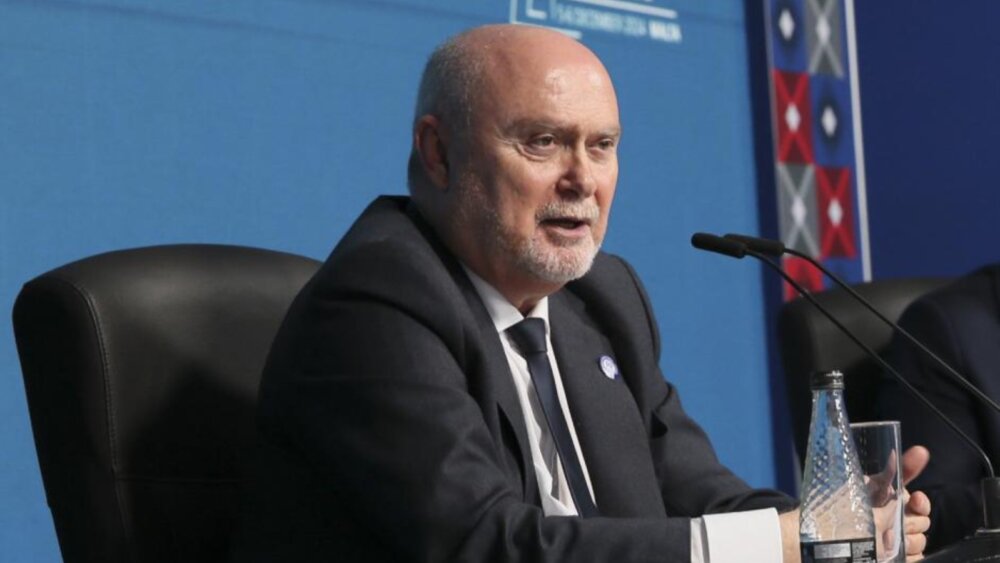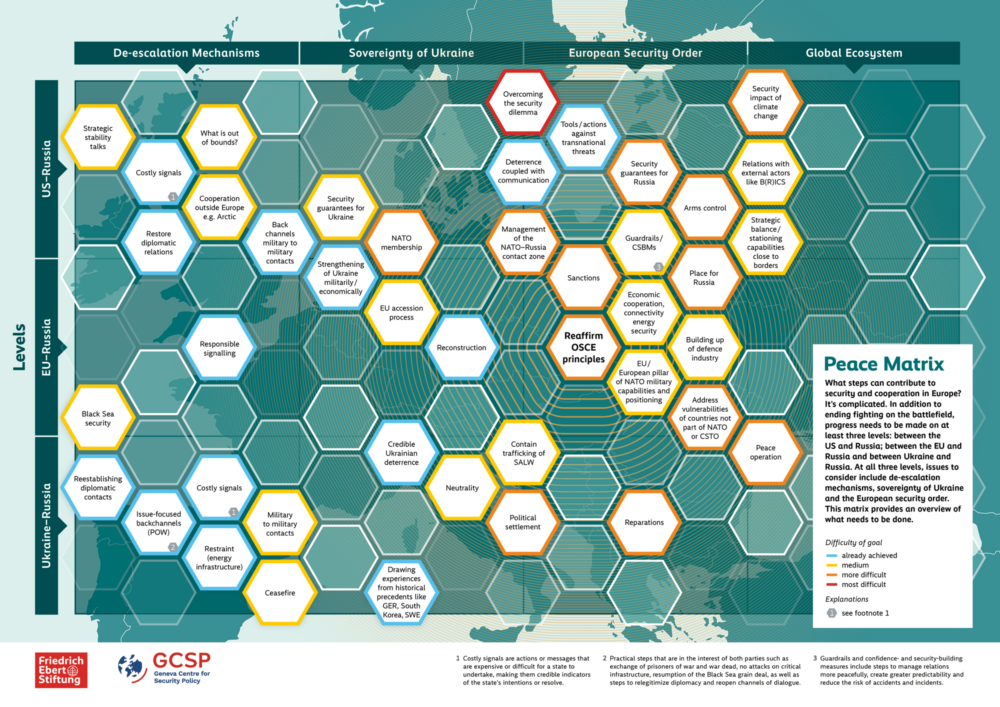To the Panel of Eminent Persons: The Ailing Euro-Atlantic Security Architecture: Treat the Causes not the Symptoms
The current crisis in and around Ukraine is a symptom of a much deeper crisis of the European security architecture and the role that the Organization for Security and Co-operation (OSCE) plays in it. The renewed East-West confrontation, the lack of progress on arms control issues and on how to reestablish a dialogue on co-operative security in the OSCE area, as well as the OSCE’s inability to make progress regarding the protracted conflicts, and continuous disagreement about the main role of the OSCE are all symptoms of that same crisis.
The Panel of Eminent Persons that has been tasked at the 2014 OSCE Basel Ministerial Council meeting with elaborating recommendations on how to reconsolidate European security, should address the root causes and not merely develop recommendations that treat the symptoms. The main cause of the Ukraine crisis and the renewed East-West confrontation is the fact that the West and Russia have fundamentally differing views regarding the design of the European security architecture. This stems from the fact that the current security architecture only meets the interests of some of the states but not of all of them. This is not meant to justify Russian actions in eastern Ukraine or Crimea. It is merely an attempt to explain the root causes of the current crisis and to develop creative solutions. One solution would be to think about how to create a common Euro-Atlantic/Eurasian security architecture that meets the security and economic interest of all states, including the United States, the EU member states and Russia.
In order to understand the causes of the current crisis of the European security architecture, it is helpful to look back in time. While the first symptoms started appearing around 1999/2000 onwards, the foundations of the crisis had been laid much earlier.
When the Cold War came to an end in 1989, Mikhail Gorbachev started referring to a ‘Common European Home’, based on the Conference on Security and Co-operation in Europe (CSCE) and a system of collective security. The Soviet leader suggested that the CSCE and the concept of collective security should replace the system of competing alliances (NATO and the Warsaw Pact). When the Soviet Union collapsed, Russia continued to support the idea of a strong CSCE/OSCE. As P. Terrence Hopmann explains, “Russia advocated that the OSCE should become the main institution responsible for security in Europe, an umbrella for all security organizations on the continent, including NATO, the Western European Union (WEU), and the Commonwealth of Independent States (CIS), which linked some of the post-Soviet states in a loose military and economic arrangement” (Hopmann, 2010, p. 247) Indeed, in the run-up to the 1994 CSCE/OSCE Budapest Summit, Russia suggested that the CSCE should be transformed into a treaty-based international organization with a decision-making body comparable to the UN Security Council. Yet, only a few years later, in 1999, NATO enlarged to the East and with that, Russia had to abandon its suggestion to use the CSCE/OSCE to create a pan-European security institution.
In 1997 Russia tabled a proposal for a ‘Charter on European Security’ that was eventually adopted at the 1999 OSCE Istanbul Summit. The Charter contained the following sentence: “The Charter will contribute to the formation of a common and indivisible security space. It will advance the creation of an OSCE area free of dividing lines and zones with different levels of security.” In the coming years, this was to become a Russian mantra, with Russian politicians repeating it at every possible occasion. In addition, as part of the Charter, a platform for co-operative security was adopted, the goal of which was to “offer the OSCE, when appropriate, as a flexible co-ordinating framework to foster co-operation, through which various organizations can reinforce each other drawing on their particular strengths” […] without creating “a hierarchy of organizations or a permanent division of labour among them.” As Andrei Zagorski analyses, “[f]rom this, it is clear that Russia had abandoned its former concept of a hieratical system of European security with the OSCE at its head” (as cited in Zellner, 2005, p. 393). Yet, the Russian view of a common and indivisible security space remained intact.
The year 1999 is seen by many analysts as a turning point in how Russia views the West and the OSCE. Although the 1999 OSCE Istanbul Summit adopted the Charter for European Security, it was overshadowed by the NATO bombing campaign of Serbia, that started in March 1999 and that was initiated without a mandate from the UN Security Council. Russia felt betrayed by its partners and came to realize that the European security architecture and indeed the OSCE were working against its interests. In this regard, Hopmann also cites what Russia viewed as a premature closing of the OSCE missions in Estonia and Latvia at the end of 2001 and the integration of the Baltic countries into NATO (Hopmann, 2010, p. 258). The missions were serving Russian interests as they were mandated to help ethnic Russians gain basic political and minority rights in the Baltic countries.
Although Russian views on the OSCE changed, it continued to maintain that there was a need for a common and indivisible security space without dividing lines and zones with different levels of security. However, whilst NATO members gained security, Russia, in its view, lost security given the collapse of the Soviet Union and the integration of some of its successor states into NATO. In addition, the EU also enlarged to the East and thus provided economic advantages to its new members through the EU common market. The goal of creating an indivisible security space was further hampered when NATO decided to deploy missile defense systems in Poland and the Czech Republic (cancelled in 2009).
It therefore should have come as no surprise when then Russian President Dimitry Medvedev, in a speech in Berlin in 2008, proposed a new European Security Treaty to which all current organizations could become party. In his speech, Medvedev stressed that “[w]e especially need to be aware of the consequences of marginalising and isolating countries, creating zones with differentiated levels of security and abandoning the creation of general regional collective security systems. Unfortunately, all this can be found in Europe today.” This speech clearly showed how Russia was dissatisfied with the European security architecture and with the fact that the OSCE had not been able in the past to fulfill the role of a pan-European security institution.
As a reaction, a consultation process was initiated in the framework of the OSCE. Yet, it seemed that Western states were against the idea of negotiating a new security treaty, but rather wanted to maintain the current system of security organizations. One of the initial results of the OSCE consultation process was the adoption under the 2010 Kazakh OSCE Chairmanship of the Astana Commemorative Declaration Towards a Security Community. This declaration clearly stated the Russian interest since the end of the Cold War of creating a “free, democratic, common and indivisible Euro-Atlantic and Eurasian security community stretching from Vancouver to Vladivostok, rooted in agreed principles, shared commitments and common goals. […] It should unite all OSCE participating States across the Euro-Atlantic and Eurasian region, free of dividing lines, conflicts, spheres of influence and zones with different levels of security.” However, while the Astana Summit participants were able to agree on a common vision in the Astana Declaration, they could not reach consensus on a plan of action that would move them closer to that goal. In addition, the discussions within the Helsinki+40 process that were initiated in 2012 have not produced concrete results, as they have either looked at symptoms (protracted conflicts, lack of progress on conventional arms control) or at issues not related to the core problem (transnational threats, economic and environmental issues, OSCE institutional reform).
Meanwhile, Russia has reacted by creating its own security architecture in the form of the Eurasian Economic Union (that includes Belarus, Kazakhstan and Russia) and in the form of the Collective Security Treaty Organization (that includes Armenia, Belarus, Kazakhstan, Kyrgyzstan, Russia and Tajikistan). Both organizations are generally seen as opposites to the EU and NATO, respectively. Hence, there is a trend that the Euro-Atlantic and Eurasian halves of the OSCE area are drifting apart instead of being united in a security community.
In addition, the symptoms of the broader crisis of European security have become more acute. Since 2002, the OSCE has not been able to agree by consensus on a Ministerial Declaration, there is no concrete progress on the protracted conflicts, Russia recognized Abkhazia and South Ossetia as independent states after the brief war with Georgia in 2008 and refused to extend the mandate of the OSCE mission to Georgia, and in 2014 Russia annexed the Crimean Peninsula and began its support for the separatist movement in eastern Ukraine. Furthermore, Russia has increasingly become skeptical of ODIHR election monitoring, and believes that the West is placing too much emphasis on the human dimension.
Indeed, it seems that the protracted conflicts have become an instrument for Russia to keep its influence in its ‘near abroad’ and to weaken the chances of NATO and EU membership of Ukraine, Georgia and Moldova. It is therefore likely that the crisis in Ukraine will turn into another protracted conflict and that new symptoms will develop in the near future.
This can only be countered by developing a common Euro-Atlantic/Eurasian security architecture that meets the security and economic interests of all states. Therefore, the Panel of Eminent Persons should develop a plan of action on how to translate the 2010 Astana vision into reality. As the Astana Commemorative Declaration stresses “[m]istrust and divergent security perceptions must be overcome.” OSCE participating States should take up the Panel’s recommendations and endorse them at the upcoming OSCE Ministerial Council meeting in Belgrade in December 2015.
References:
Hopmann, P.T. (2010) ‘Intergovernmental Organizations and Non-State Actors, Russia and Eurasia: The OSCE’, M.R. Freire, R.E. Kanet (Eds.), Key Players and Regional Dynamics in Eurasia: The Return of the ‘Great Game’ (Hampshire, United Kingdom, New York, United States: Palgrave Macmillan)
Zellner, W. (2005) ‘Russia and the OSCE: From High Hopes to Disillusionment’, Cambridge Review of International Affairs, 18(3), pp. 389-402.



Comments
* Your email address will not be published